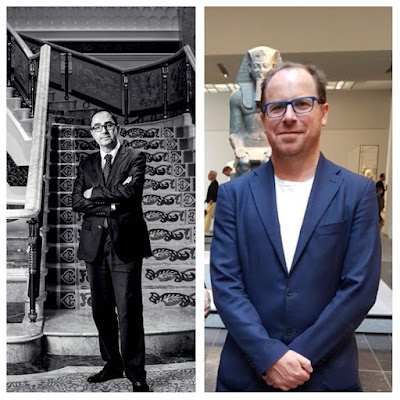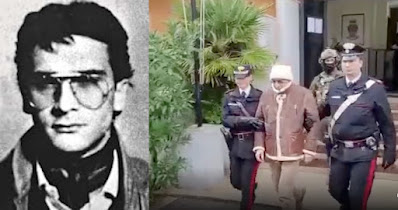Palermo prosecutor Maurizio de Lucia and with the deputy prosecutor Paolo Guido confirmed today that longtime fugitive, Cosa Nostra boss, Matteo Messina Denaro, A.K.A. "Diabolik," has been captured by anti-Mafia Carabinieri, this morning during the early hours. He was arrested at a bar, adjacent to “La Maddalena” a private health clinic and hospital in the San Lorenzo, district of Palermo where he had been undergoing treatment. The hospital is a medical-surgical level III facility for oncology. He's since been photographed being walked out of a Carabinieri palazzo in dark glasses and an oversized coat, before being placed in a a waiting vehicle to transport him to a secure cell.
Sentenced to life in prison
in absentia in 1992, Messina Denaro solidified his position in the mafia following the arrests of two of his predecessors, Salvatore "Totò" Riina in 1993 and Bernardo Provenzano in 2006. A fugitive since 1993, he had been convicted for the Sicilian mafia's bombing campaign in the early 1990s, which killed two anti-mafia prosecutors, Giovanni Falcone and Paolo Borsellino, and others in Sicily, Rome and Florence.
One of Cosa Nostra's more brutal bosses, he once boasted "I filled a cemetery all by myself."
In 2012, while still on the lam, Matteo Messina Denaro was one of mafia members people given an additional sentence of life imprisonment, this time for the murder of 12 year old Giuseppe Di Matteo, dissolved in a barrel of acid. Di Matteo's father, Santino Di Matteo, was one of the participants in the killing of Antimafia judge Giovanni Falcone on 23 May 1992. After his arrest on 4 June 1993, he became a government witness – a pentito, a move which ultimately made his son a target.
According to Giovanni Brusca, an Italian mobster and former member of the Corleonesi clan, Matteo Messina Denaro was also the facilitator of the 1993 Uffizi gallery bombing in Florence. During that incident, a Fiat car packed with 100kg of explosives detonated killing six people, and destroying three paintings - two by Bartolomeo Manfredi and one by the Gherardo delle Notti.
Messina Denaro was also implicated in the bombing of the Basilica of St. John Lateran in Rome.
Messina Denaro is credited with having created Trapani branch of Cosa Nostra, which infiltrated the economy, businesses and banks in the area. Investigative seizures made by authorities in connection with this boss are so extensive it is hard to tell where the economy of western Sicily stops and Denaro’s mafia-controlled empire begins.
As the word spread throughout Palermo of his arrest, officers received hugs and praise, as cars throughout the city, blared their horns welcoming his arrest.
But those who have long lived in the shadow of the powerful clans, are worried that the apparently ailing mobster, now 60 years old, had already handed over the reigns to another, and may have gotten sloppy about where he was, or even perhaps let law enforcement in on his treatment. With a police press conference scheduled for 17:00 CET, perhaps more will be discussed regarding his underlying medical condition, which some say is a tumour in his stomach that he was being treated for over an extended period of time, benefiting from the use of a false identity document.
Will the medical issues of this crime boss affect his sentencing? This remains to be explored.
What is known is that he comes from a long blood line of mafia family members, some of whom are equally worth remembering.
Francesco Messina Denaro - Capo Mandamento of the Castelvetrano family, and the head of the mafia commission of the Trapani region, died in hiding in 1998 while he too was a fugitive from justice. It was after his father's death that Matteo Messina Denaro took over his father's enterprise. A close ally to the Corleone faction led by Salvatore "Totò" Riina and Bernardo Provenzano, Francesco Messina Denaro was known as Don Ciccio, and headed the Castelvetrano family from 1981 until 1998.
Patrizia Messina Denaro - Is the sister of the former fugitive and is believed to have served as a Capodonna representative of the Castelvetrano family while living in that city. Incarcerated, she is serving a 14 year and 6 months sentence for acting as stand in for her brother. She was found guilty of being a full member of the Mafia and not an affiliate mafia. Several firms including an olive-oil company belonging to her and her husband were impounded and a number of bank accounts frozen.
Salvatore Messina Denaro was arrested on 15 March 2010, along with 18 others in operation "Golem 2" as a principal in a network surrounding his fugitive brother. Living in Campobello di Mazara, he was charged with organising Matteo Messina Denaro's secret correspondence in order to help him remain on the run, as well as mafia association, corruption and protection rackets. In this case Palermo financial police in execution of three separate orders issued by the Prevention measures offices of the Palermo and Trapani Courts seized real estate holdings worth 1.8 million euros.
Update 17 January 2020
The carabinieri ROS and the Palermo prosecutor's office have identified the hideout of where Matteo Messina Denaro, arrested on January 16 at the Maddalena clinic in Palermo, had apparently been hiding, for at least part of the last thirty years. This residence is in the heart of Campobello di Mazara, (7.7 km from Castelvetrano), the same city where his driver and fiancheggiatore, Giovanni Luppino, is from. Luppino himself is an olive merchant, who before yesterday was said to have a clean record. He is not believed to be a relation to Messina Denaro loyalist Franco Luppino.
What officers uncover in this house or other houses used by the boss and his facilitators, as well as in his phone, could prove interesting. The fugitive boss, in addition to his own criminal history, is said to have possibly held the Totò Riina archives, once held in a safe that was removed from Riina's hideout in via Bernini. The documents in that safe might demonstrate a lot of the mafia's strategies during the Years of Lead.
According to a news reports published by ANSA, Matteo Messina Denero's arrest came following leads which had been developed through a traditional policing investigation and not via an informant's leak of the crime boss' location yesterday. Using the methodology of draining the lake around the fugitive; law enforcement worked to remove his network of low level and influential godfather loyalists charging as many of them as possible for aiding and abetting.
Officers also tapped telephones including those of family and clan members thought to be co-involved. It is from these wiretap interceptions that officers first learned of Messina Denero's illness, even if many of these recorded conversations were coded, as those under observation were aware that their phones were likely tapped.
From there investigators began combing through health records from the Ministry of Health, focusing on male cancer patients, narrowing down the list of individuals who had or were undergoing treatment who were on/around the same age as Messina Denaro. Among those, was an individual with the name "Andrea Bonafede." Which, aside from the irony of the last name, matches a known family relative, whose medical records indicated had purportedly undergone surgery at La Maddalena one year ago, to remove liver metastases that had formed from colon cancer.
Following this lead it was determined that the real Andrea Bonafede was at his home on the purported day of this surgical intervention and with this lead a sting was arranged to coincide with one of the imposter's scheduled chemotherapy appointments, who had been using Bonafede's identity for scheduled treatments for the last year. This resulted in the dramatic capture of Messina Denaro yesterday while he waited in the queue having done his COVID test prior to receiving treatment. This while other patients were kept outside the facility, for hours, to allow officers to more readily identify the mafia boss when he arrived for his scheduled appointment time.
 ceramics,museum theft,Princessehof Ceramics Museum
ceramics,museum theft,Princessehof Ceramics Museum
 No comments
No comments


























